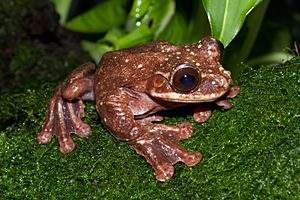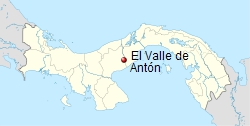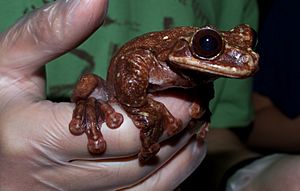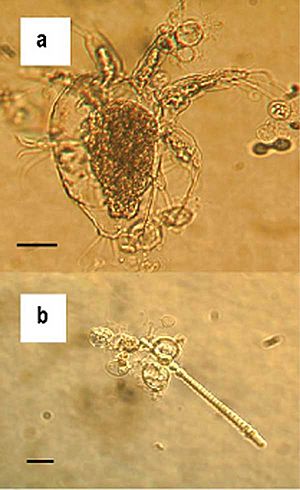Rabbs' fringe-limbed treefrog facts for kids
Quick facts for kids Rabbs' fringe-limbed treefrog |
|
|---|---|
 |
|
| Conservation status | |
| Scientific classification | |
| Genus: |
Ecnomiohyla
|
| Species: |
rabborum
|
 |
|
| El Valle de Antón in Panama, the native location of the species | |

The Ecnomiohyla rabborum, also known as the Rabbs' fringe-limbed treefrog, is a type of frog that is now likely extinct. These frogs were quite large and lived high up in the forest canopy in central Panama. Like some other treefrogs, they could glide through the air. They did this by spreading their huge, fully webbed hands and feet as they jumped from trees.
Male Rabbs' treefrogs were very protective of their homes. They would guard tree holes filled with water that were used for breeding. The males were also responsible for taking care of their young, including feeding them. This frog species was special because its tadpoles got their food by eating tiny pieces of skin from their fathers. This was the only known frog species to do this!
Scientists discovered this frog in 2005 and officially described it in 2008. It was named after two conservationists and frog experts, George B. Rabb and Mary S. Rabb. By 2009, the frog was listed as Critically Endangered. It is believed that the species disappeared from the wild because of a serious frog disease caused by a fungus. Sadly, even with efforts from conservation teams, breeding programs in zoos did not work. The last known female frog died in 2009. The very last known Rabbs' treefrog, a male named Toughie, lived at the Atlanta Botanical Garden until he died on September 26, 2016.
Contents
What Did the Rabbs' Treefrog Look Like?
The Rabbs' fringe-limbed treefrog was a large frog. Males were usually between 62 and 97 millimeters (about 2.4 to 3.8 inches) long, and females were between 61 and 100 millimeters (about 2.4 to 3.9 inches) long. Their heads were wider than their bodies and flat on top.
Their arms were short and strong, with very large hands. They had a wavy fringe of skin along their arms, from the elbows to their fingertips. Their fingers were short with large, flat pads at the tips. All their fingers were almost completely webbed.
Their back legs were thin and medium-sized. Like their hands, their feet were very big. They also had a wavy fringe of skin along their legs, from the heel to the base of their feet. Their toes had flat pads at the tips and were also fully webbed.
The skin of the Rabbs' treefrog felt bumpy and was mostly a mix of brown colors. The top of their legs and back were also mottled brown. The back of their thighs was light yellow. Their chin and upper chest were brown, but the rest of their belly was mostly white with brown spots. They had green speckles on their eyelids, legs, and back. These speckles could change color and position! Their eyes had a reddish-brown color.
During the breeding season, male Rabbs' treefrogs had much larger upper arms. These arms had a bony ridge covered in skin and black, tough spines. Spines were also found on the area just before their "thumbs." These spines were likely used when the frogs mated.
How Was This Frog Named?
The Rabbs' fringe-limbed treefrog belongs to the Ecnomiohyla group of treefrogs. It was first described in 2008 by a team of herpetologists (scientists who study reptiles and amphibians). The team included Joseph R. Mendelson III, Jay M. Savage, Edgardo Griffith, Heidi Ross, Brian Kubicki, and Ronald Gagliardo. When they found the frog in 2005, they first thought it was a different species. But Brian Kubicki realized it was a new kind of frog. The first frogs studied were raised in captivity from tadpoles collected in Panama in 2005.
The name Ecnomiohyla comes from ancient Greek words meaning "marvelous" or "unusual" and "Hylas," who was a friend of Hercules. The name rabborum was chosen to honor the conservationists and herpetologists George B. Rabb and Mary S. Rabb.
Where Did the Rabbs' Treefrog Live?
The Rabbs' fringe-limbed treefrog was only found in the cloud forests of Panama. These forests are on the mountains facing the Pacific Ocean, near the town of El Valle de Antón. The area where they lived was very small, less than 100 square kilometers (about 38 square miles), at heights of 900 to 1150 meters (about 2,950 to 3,770 feet) above sea level. Sadly, no Rabbs' treefrogs have been seen in the wild since 2007.
Life and Habits of the Rabbs' Treefrog
Like other frogs in its group, the Rabbs' treefrog lived high up in the forest canopy. They were nocturnal, meaning they were active at night, and they ate insects. When they felt threatened, they could glide through the air. They would leap from their high perches and fully stretch out their huge, webbed hands and feet. They could even control where they landed! Scientists saw them glide for distances of up to 9 meters (about 30 feet).
Male Rabbs' treefrogs were very protective of their breeding spots, which were tree holes filled with water. The males would make special calls to attract females. Their calls sounded like an owl's "warm up" calls, followed by a single "grrrrrck" or barking sound. They called only at night for about one to two minutes at a time. These calls also helped warn other males to stay away. Mating happened all year, but the calls became louder around the full moon and during the main mating season from mid-March to May.
Females laid their eggs inside the water-filled tree holes, sticking them to the wood just above the water. After laying eggs, the females left, and the males stayed to guard them. A single tree hole could hold a clutch of 60 to 200 eggs. The eggs hatched into large tadpoles with flat bodies and short, blunt snouts. Their eyes were on top of their heads. The tadpoles were mostly pale brown. When their legs first appeared, they were about 25 to 27 millimeters (about 1 inch) long. There were so many tadpoles in the tree holes that sometimes it looked like there was more tadpole than water!
A truly amazing thing about E. rabborum was how the males fed their young. During the day, the male frogs would back into the water-filled tree holes where the tadpoles lived. They would stay half-submerged until night. While they were there, the tadpoles would swim around them and gently scrape off small pieces of skin from their fathers' backs to eat. This was the first time scientists had ever seen a frog species do this. It's similar to how some female caecilians (a type of amphibian) feed their young.
Why Did the Rabbs' Treefrog Disappear?
When scientists first collected the Rabbs' treefrog, they already knew about a big threat: a fungus called Batrachochytrium dendrobatidis, often called "Bd." This fungus causes a serious disease in amphibians called chytridiomycosis. This disease has caused many amphibian species to decline or go extinct in places like the Americas, Australia, and New Zealand. Infected frogs can become slow, act strangely, have seizures, and their skin might peel. Eventually, they die. No one knows for sure where this disease came from, but some think it spread worldwide through the African clawed frog.
In 2006, hoping to save the Rabbs' treefrog, scientists sent some of these frogs to special breeding centers. These included the El Valle Amphibian Conservation Centre (EVACC), Zoo Atlanta, and the Atlanta Botanical Garden. However, these efforts didn't work. The frogs lived well in these places but never mated. The last female frog died in 2009 at the Atlanta Botanical Garden.
Joseph R. Mendelson III, one of the scientists who first described the Rabbs' treefrog, said that in the last 20 years, frog experts are becoming like "detectives." They are describing new species right before or even after they have already gone extinct. About the Rabbs' treefrog, he said:
It appears that nature has run its course before three teams of dedicated people were able to determine the needs of these frogs in order for them to reproduce. To have been a part of one of those teams has been a frustrating and sad experience.
Two male frogs survived until February 17, 2012. One of them had to be given a peaceful death at Zoo Atlanta because he was very sick. This was done to prevent him from suffering and to save important genetic material. If he had died naturally during the night, it might have been impossible to get genetic samples. Dwight Lawson, the Deputy Director of the Zoo, said:
This is the second time in my career that I have literally seen one of the very last of its kind die and an entire species disappear forever with it. It is a disturbing experience, and we are all poorer for it. The ongoing amphibian extinction crisis has taken a rich diversity of animals from us, and more effort and resources are desperately needed to halt the losses.
The last time anyone saw a Rabbs' treefrog in the wild was in 2007, when a male was heard calling. By 2009, the frog was listed as Critically Endangered. Now, scientists believe the species is effectively extinct in the wild. The last known frog, a male named Toughie, lived at the Atlanta Botanical Garden until he passed away.
See also
 In Spanish: Ecnomiohyla rabborum para niños
In Spanish: Ecnomiohyla rabborum para niños
- Decline in amphibian populations
- Chytridiomycosis
- Holocene extinction
- Anthropocene



